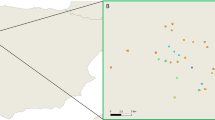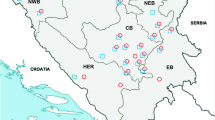Abstract
Carnivores are potential carriers of agents that infect their prey species, even though they themselves are not susceptible, such as the lagovirus that causes European brown hare syndrome (EBHS), a severe disease of brown hares endemic in Europe. During our wildlife surveillance in Lombardy, we identified an EBHS outbreak in a protected area by both virological analyses (sandwich ELISA and RT-PCR) of the target organs from one dead hare and serological examinations (competitive ELISA) of captured animals. Since four red foxes were contemporarily hunted in the same area, we examined their organs by RT-PCR for the EBHS agent (EBHSv). The intestinal content of one fox tested positive, while the fox’ other organs (liver, spleen, and mesenteric lymph nodes), and all of the samples from the remaining three foxes, tested negative. Moreover, in the gastrointestinal content of the positive fox, we found food debris that was genetically identified as being of hare origin. The competitive ELISA test for EBHSv antibodies gave negative results in all of the fox sera. Genetic analyses of the EBHSv amplicons obtained by RT-PCR in the hare and the fox indicated a full homology (99.9 % nucleotide and 100 % amino acid identity). These results support the fact that red fox, as other predators, feeding on EBHSv infected hares may have genetic prints of the virus in their gut contents. Even if we did not prove that lagovirus particles remained infective in the excreted feces and, thus, contaminated the ground in the outbreak area, these eventualities cannot be excluded, and we could at least conclude that red foxes might assume a potential role in the indirect transmission of lagovirus, as EBHSv.
Similar content being viewed by others
References
Capucci L, Scicluna MT, Lavazza A (1991) Diagnosis of viral haemorrhagic disease of rabbits and European brown hare syndrome. Rev Sci Tech Off Int Epiz 10:347–370
Cecere JG, Benedetti MC, Guj I, Imperio S (2014) The role of the red fox as a predator of species of human concern in a Mediterranean rural habitat: a case Study. Russ J Ecol 45:555–558
Chiari M, Ferrari N, Giardiello D, Avisani D, Zanoni M, Alborali GL, Lanfranchi P, Guberti V, Capucci L, Lavazza A (2014) Temporal dynamics of European brown hare syndrome infection in Northern Italian brown hares (Lepus europaeus). Eur J Wildl Res 60:891–896
Dell’Arte GL, Laaksonen T, Norrdahl K, Korpimäki E (2007) Variation in the diet composition of a generalist predator, the red fox, in relation to season and density of main prey. Acta Oecol 31:276–281
Duff JP, Gavier-Widén D (2012) Calicivirus infection. In: Duff JP, Gavier-Widén D, Meredith A (eds) Infectious disease of wild mammals and birds in Europe. Wiley-Blackwell, Oxford, pp 73–85
Edwards PJ, Fletcher MR, Berny P (2000) Review of the factors affecting the decline of the European brown hare, Lepus europaeus (Pallas, 1778) and the use of wildlife incident data to evaluate the significance of paraquat. Agric Ecosyst Environ 79:95–103
Frölich K, Lavazza A (2008) European brown hare syndrome. In: Lagomorph Biology. Springer, Berlin/Heidelberg, Germany, pp 253–261
Frölich K, Klima F, Dedek J (1998) Antibodies against rabbit hemorrhagic disease virus in free-ranging red foxes from Germany. J Wildl Dis 34:436–442
Gustaffson K, Svensson T, Uggla A (1989) Studies on an idiopathic syndrome in the brown hare (Lepus europaeus P.) and mountain hare (Lepus timidus L.) in Sweden, with special reference to hepatic lesions. J Vet Med A 36:631–637
Halliday JE, Meredith AL, Knobel DL, Shaw DJ, de C Bronsvoort BM, Cleaveland S (2007) A framework for evaluating animals as sentinels for infectious disease surveillance. J R Soc Interface 4:973–984
Kemp BM, Smith DG (2005) Use of bleach to eliminate contaminating DNA from the surface of bones and teeth. Forensic Sci Int 154:53–61
Lavazza A, Vecchi G (1989) Osservazione su alcuni episodi di mortalità nelle lepri. Evidenziazione al microscopio elettronico di una particella virale Nota preliminare. Selezione Vet 30:461–467
Leighton FA, Artois M, Capucci L, Gavier-Widén D, Morisse JP (1995) Antibody response to rabbit viral hemorrhagic disease virus in red foxes (Vulpes vulpes) consuming livers of infected rabbits (Oryctolagus cuniculus). J Wildl Dis 31:541–544
Liebermann HT, Bergmann H, Lange E, Schirrmeier H, Solisch P (1992) Some physicochemical properties of the virus of rabbit haemorrhagic disease. J Vet Med B 39:317–326
OIE Manual of Diagnostic Tests and Vaccines for Terrestrial Animals (2010), Chapter 2.6.2. “Rabbit Haemorrhagic Disease”. World Organisation for Animal Health (OIE; ed) 6th edn. Biological Standards Commission, Paris, France, pp 941–955
Paci G, Lavazza A, Ferretti M, Santilli F, Bagliacca M (2011) Relationship between anti-European Brown Hare syndrome serological titers and Brown Hare (Lepus europaeus Pallas) densities. Int J Zoo. doi:10.1155/2011/436193
Panek M (2013) Long-term changes in the feeding pattern of red foxes Vulpes vulpes and their predation on brown hares Lepus europaeus in western Poland. Eur J Wildl Res 59:581–586
Philbey AW, Kirkland PD, Saunders GR (2005) Assessment of antibodies to rabbit haemorrhagic disease virus in fox serum as an indicator of infection in sympatric rabbit populations. Aust Vet J 83:97–100
Reynolds JC, Stoate C, Brockless MH, Aebischer NJ, Tapper SC (2010) The consequences of predator control for brown hares (Lepus europaeus) on UK farmland. Eur J Wildl Res 56:541–549
Schmidt NM, Asferg T, Forschhammer MC (2004) Long-term patterns in European brown hare population dynamics in Denmark: effects of agriculture, predation and climate. BMC Ecol 4:15
Simón MDC, Muguruza R, Alonso JL, Muzquiz C, Girones O, Haffar A (1994) Recherche du virus de la maladie hémorrhagique virale du lapin (RHD) chez le renard et rôle des canidés domestiques dans la transmission de la maladie. Rec Méd Vét 179:841–845
Soulsbury CD, Iossa G, Baker PJ, White PC, Harris S (2011) Behavioral and spatial analysis of extraterritorial movements in red foxes (Vulpes vulpes). J Mammal 92:190–199
Wirblich C, Meyers G, Ohlinger VF, Capucci L, Eskens U, Haas B, Thiel HJ (1994) European brown hare syndrome virus: relationship to rabbit hemorrhagic disease virus and other caliciviruses. J Virol 68:5164–5173
Acknowledgments
The authors gratefully acknowledge the local hunters (Ambito Territoriale di Caccia Unico di Brescia, Brescia Province, Northern Italy). Without their cooperation, this study would not have been possible.
The authors wish to thank Giuseppe Orlandi, Giuseppe Bertocchi, Cristina Palotta, and Giuliana Botti of the Brescia laboratory of IZSLER for their technical support.
The authors wish to thank Lesley Benyon (ScienceDocs) for the editing of this manuscript.
Author information
Authors and Affiliations
Corresponding author
Ethics declarations
Conflict of interest
The authors declare that they have no conflict of interest.
Rights and permissions
About this article
Cite this article
Chiari, M., Molinari, S., Cavadini, P. et al. Red foxes (Vulpes vulpes) feeding brown hares (Lepus europaeus) infected by European brown hare syndrome virus (EBHSv) might be involved in the spread of the virus. Eur J Wildl Res 62, 761–765 (2016). https://doi.org/10.1007/s10344-016-1055-4
Received:
Revised:
Accepted:
Published:
Issue Date:
DOI: https://doi.org/10.1007/s10344-016-1055-4




